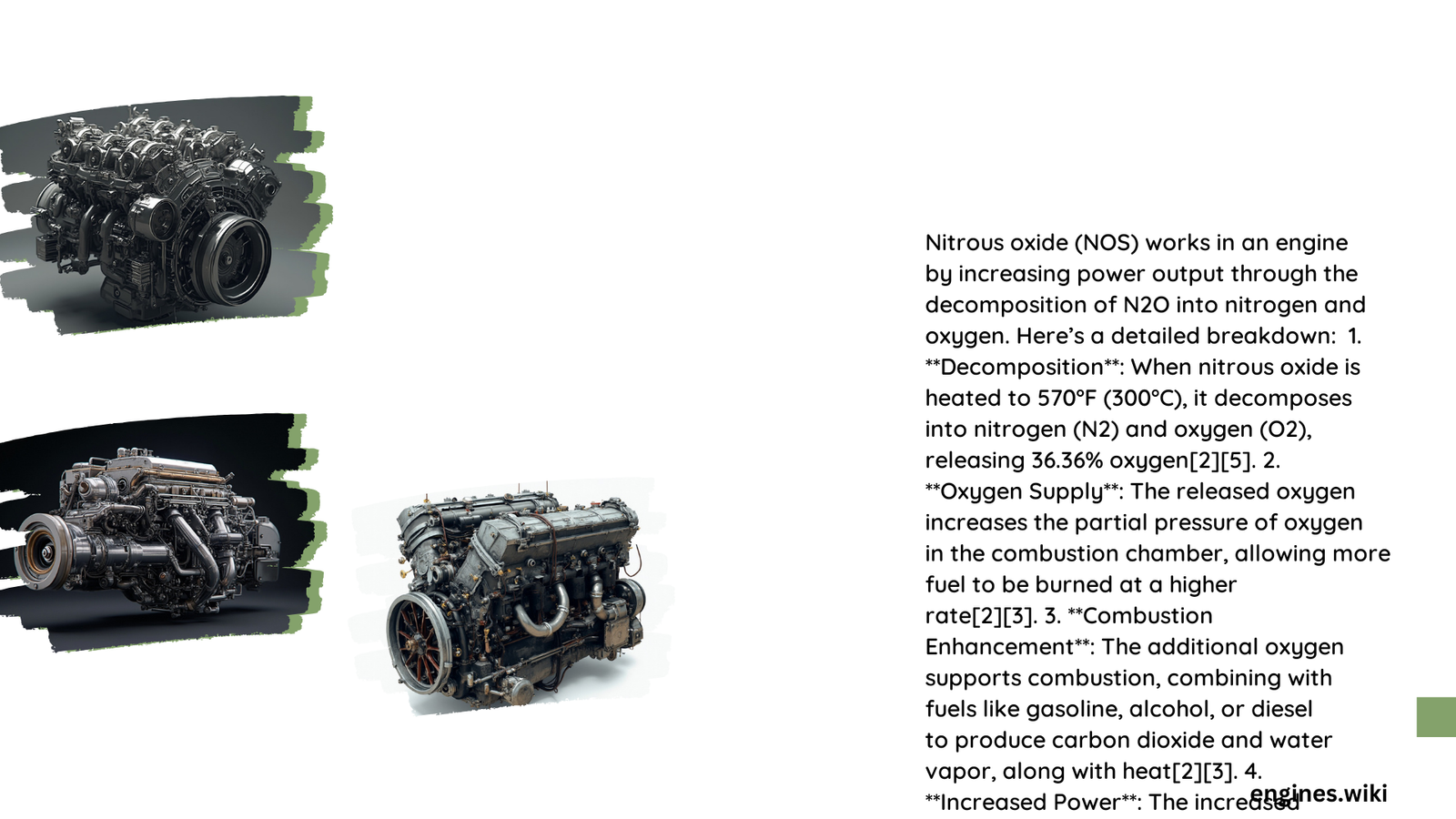Nitrous Oxide Systems (NOS) represent a sophisticated power enhancement technology that transforms engine performance by introducing additional oxygen into combustion chambers. By decomposing nitrous oxide into oxygen and nitrogen, these systems enable dramatically increased fuel burning efficiency, generating substantial horsepower gains through precise chemical and mechanical interactions within automotive engines.
What Happens During Nitrous Oxide Decomposition?
Chemical Transformation Process
Nitrous oxide (N₂O) undergoes a remarkable chemical decomposition when injected into an engine’s combustion chamber. The key transformation involves:
- Oxygen Release: N₂O breaks down into oxygen (O₂) and nitrogen (N₂)
- Oxygen Concentration: Increases from standard 21% to 36.36%
- Temperature Range: Decomposition occurs at 570-580°F
Pressure and Temperature Dynamics
| Parameter | Specification |
|---|---|
| Liquid Pressure | 11 lbs per degree Fahrenheit |
| Temperature Drop | 60-80 degrees during vaporization |
| Volumetric Efficiency | Increased due to charge cooling |
How Does Nitrous Oxide Enhance Engine Performance?

Power Generation Mechanism
Nitrous oxide systems generate additional power through:
- Increased Oxygen Supply
- More oxygen allows greater fuel combustion
- Enables rapid energy release
-
Supports higher horsepower production
-
Charge Cooling Effect
- Liquid nitrous oxide reduces intake charge temperature
- Prevents premature detonation
- Protects engine components from excessive heat
Horsepower Potential
- Typical Gains: 50-150 horsepower
- Activation Range: Typically above 4000 RPM
- Performance Enhancement: Recovers lost torque at higher engine speeds
What Components Comprise a Nitrous Oxide System?
Critical System Elements
- Nitrous Bottle: Stores liquid nitrous oxide
- Solenoids: Control nitrous and fuel flow
- Injectors/Nozzles: Introduce nitrous and fuel mixture
- Pressure Regulators: Manage system pressure
What Risks Accompany Nitrous Oxide Usage?
Potential Challenges
- Excessive Heat Generation
- Increased Combustion Pressure
- Potential Engine Component Stress
Mitigation Strategies
- Proper system calibration
- Appropriate ignition timing adjustments
- Use of reinforced engine components
- Professional installation and tuning
Cost and Installation Considerations
System Types and Pricing
| System Type | Cost Range | Installation Complexity |
|---|---|---|
| Plate System | $500-$1,000 | Low |
| Direct-Port System | $1,500-$3,000 | High |
Technical Recommendations
Performance Optimization
- Select appropriate nozzle calibration
- Adjust ignition timing
- Maintain precise fuel-to-nitrous ratios
- Use high-quality forged internal components
Safety Protocols
- Regular system inspections
- Professional tuning
- Gradual power increase
- Comprehensive engine preparation
Expert Insights
Successful nitrous oxide system implementation requires deep understanding of engine dynamics, precise engineering, and meticulous attention to mechanical tolerances. Professional guidance is strongly recommended for optimal performance and longevity.
References:
1. CarParts.com – Nitrous Oxide Explanation
2. Wikipedia – Nitrous Oxide in Engines
3. Technical Automotive Performance Resources
